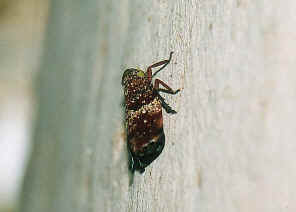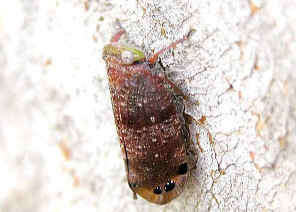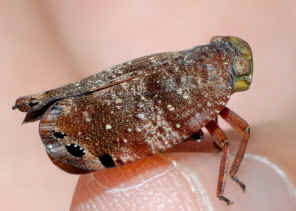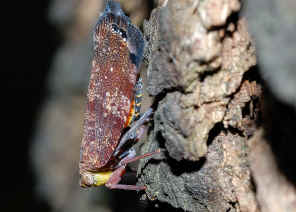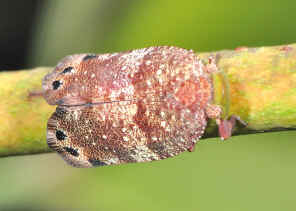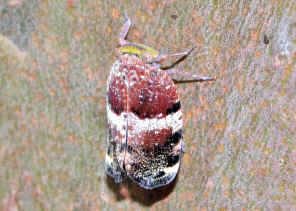Green Face Gum Hopper - Platybrachys decemmacula
Family Eurybrachyidae
This page contains pictures and information about Green Face Gum Hoppers that we found in the Brisbane area, Queensland, Australia.

- Female, body length 20mm
- This Green Face Gum Hopper is usually found on large gumtree trunks, occasionally found on stem or leaves. It seems that they prefer smooth bark gum tree, although they are also found on other type of gum tree. They are common in Eucalyptus forests in Brisbane.



- Female Male Nymph
- Green Face Gum Hoppers are brown in colour. On the head there is the large and flat frons which is yellowish green to bright green. All legs are brown with three black spines on hind legs. Forewings are brown with white dotted marks. There are five dark blue spots along the outer edge of forewings, three on the fore border and two at the tip with the third smaller than the others. There are also a row of short parallel cross-veins along the fore border. Hind-wings are blackish in colour and paler near the wing base.


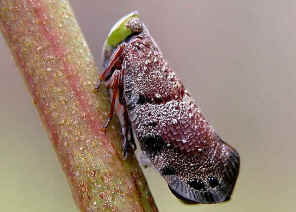
- On tree trunk, the Green Face Gum Hoppers are usually facing upwards or downwards. The green face provides a good camouflage colour for those predators sitting on stem or tree trunk.



- The Green Face Gum Hoppers can be found on leaves, on stems or on trunk of gumtrees..
Nymphs
-


- Body length 10mm
- The nymph pictures were taken on the same gum tree trunk with the adults early summer. We believed they are the same species.
Female about to lay eggs
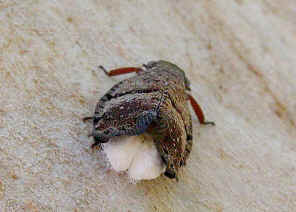

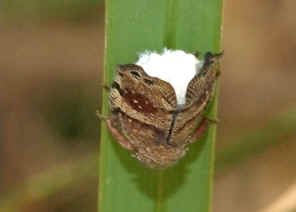
- From the white waxy look on its abdomen tip, we can tell the above planthopper is a matured female. Females lay eggs on tree trunks or leaves. The eggs are covered with a white waxy secretion produced by the ovipositing female.
Fake Head on Wings gives the Insect Second Chance
- The Planthopper is brown with white patterns on wings There are the eyes pattern on wing tips.


- This Green Face Gum Hopper has the wing-tip eye patterns broken, looks like had been attacked by large predators. The eye patterns may have save its life, give the planthopper second chance to live.
- The planthopper has the eye-pattern markings on their tail -end wing-tips. Those markings effectively making the insects appear to be something that is facing the opposite direction. A confused predator, when striking at the mimic, most likely comes up with nothing more than a piece of wing and the insects get a chance to escape. The mimicry is known as Self mimicry.
Females
- Green Face Gum Hoppers have the large variations on body colour and patterns. We group those look similar as follows. However, The eye-patterns on the wing tips are always the same.
Females with five dark sports along outer wing edge and darker colours
Females with five dark sports along outer wing edge and paler colours
Females with three dark sports along outer wing edge and darker colours
Females with three dark sports along outer wing edge and paler colours
Body colours between male and female
Males
- From the reference we know that Platybrachys sp. are usually dimorphous, male and female are looked different.



- The Green Face Gum Hopper males do not have the green frons. Their frons is brown in colour.



- There are five dark blue spots along the outer edge of forewings, three on the fore border and two at the tip with the third smaller than the others. For the males, there are the distinctive white spot adjacent to the third smaller dark spot.



-


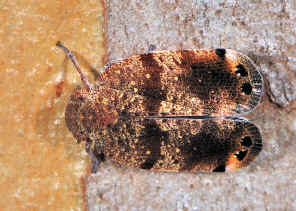
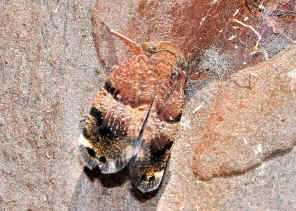


- Pictures in this page were taken in Wishart Bushland and Karawatha Forest. Green Face Gum Hoppers are common in summer. They can be found even in mid winter.
- Reference:
- 1. Platybrachys decemmacula - Fletcher, M.J. and Larivière, M.-C. (2001 and updates).
- 2. Species Platybrachys decemmacula (Walker, 1851) - Australian Biological Resources Study, Department of the Environment and Heritage.
- 3. Platybrachys decemmaculata - Insects of Townsville, Australia - Graeme Cocks, 2004.








